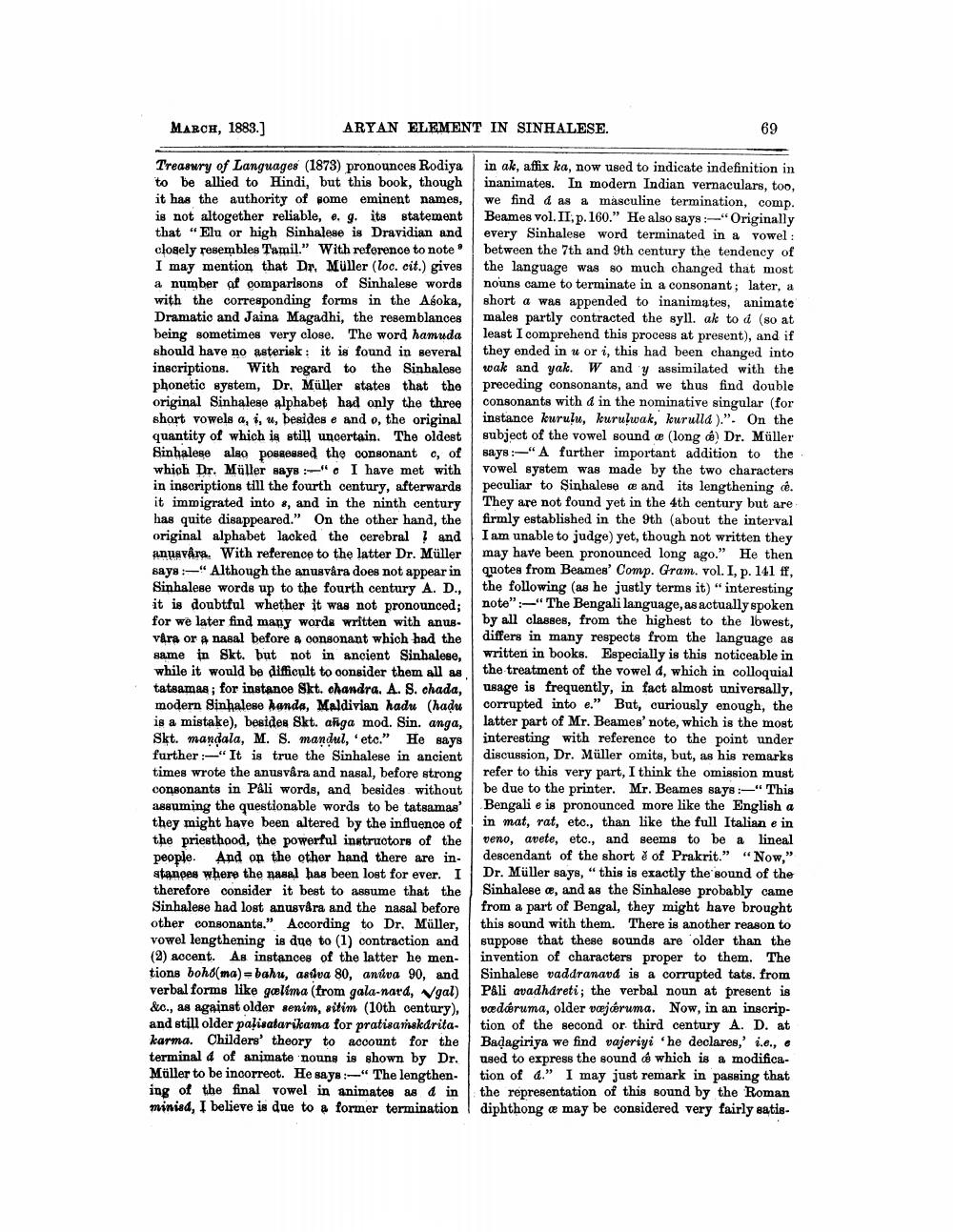________________
ARYAN ELEMENT IN SINHALESE.
MARCH, 1883.]
Treasury of Languages (1873) pronounces Rodiya to be allied to Hindi, but this book, though it has the authority of some eminent names, is not altogether reliable, e. g. its statement that "Elu or high Sinhalese is Dravidian and closely resembles Tamil." With reference to note" I may mention that Dr. Müller (loc. cit.) gives a number of comparisons of Sinhalese words with the corresponding forms in the Aśoka, Dramatic and Jaina Magadhi, the resemblances being sometimes very close. The word hamuda should have no asterisk: it is found in several inscriptions. With regard to the Sinhalese phonetic system, Dr. Müller states that the original Sinhalese alphabet had only the three short vowels a, i, u, besides e and o, the original quantity of which is still uncertain. The oldest Sinhalese also possessed the consonant c, of which Dr. Müller says:" I have met with in inscriptions till the fourth century, afterwards it immigrated into 8, and in the ninth century has quite disappeared." On the other hand, the original alphabet lacked the cerebral and anusvåra. With reference to the latter Dr. Müller says:" Although the anusvåra does not appear in Sinhalese words up to the fourth century A. D., it is doubtful whether it was not pronounced; for we later find many words written with anusvåra or a nasal before a consonant which had the same in Skt. but not in ancient Sinhalese, while it would be difficult to consider them all as tatsamas; for instance Skt. chandra. A. S. chada, modern Sinhalese kanda, Maldivian hadu (hadu is a mistake), besides Skt. añga mod. Sin. anga, Skt. mandala, M. S. mandul, etc." He says further:-"It is true the Sinhalese in ancient times wrote the anusvåra and nasal, before strong consonants in Pâli words, and besides without assuming the questionable words to be tatsamas' they might have been altered by the influence of the priesthood, the powerful instructors of the people. And on the other hand there are instances where the nasal has been lost for ever. I therefore consider it best to assume that the Sinhalese had lost anusvåra and the nasal before other consonants." According to Dr. Müller, vowel lengthening is due to (1) contraction and (2) accent. As instances of the latter he mentions boho(ma) = bahu, asuva 80, anúva 90, and verbal forms like galima (from gala-nard, gal) &c., as against older senim, sitim (10th century), and still older palisatarikama for pratisamskaritakarma. Childers' theory to account for the terminal d of animate nouns is shown by Dr. Müller to be incorrect. He says:-"The lengthening of the final vowel in animates as d in minisd, I believe is due to a former termination
69
in ak, affix ka, now used to indicate indefinition in inanimates. In modern Indian vernaculars, too, we find á as a masculine termination, comp. Beames vol. II, p. 160." He also says:-"Originally every Sinhalese word terminated in a vowel: between the 7th and 9th century the tendency of the language was so much changed that most nouns came to terminate in a consonant; later, a short a was appended to inanimates, animate males partly contracted the syll. ak to d (so at least I comprehend this process at present), and if they ended in u or i, this had been changed into wak and yak. W and y assimilated with the preceding consonants, and we thus find double consonants with d in the nominative singular (for instance kurulu, kurulwak, kurulla)." On the subject of the vowel sound ce (long ) Dr. Müller says: "A further important addition to the vowel system was made by the two characters peculiar to Sinhalese a and its lengthening d. They are not found yet in the 4th century but are firmly established in the 9th (about the interval I am unable to judge) yet, though not written they may have been pronounced long ago." He then quotes from Beames' Comp. Gram. vol. I, p. 141 ff, the following (as he justly terms it) "interesting note":"The Bengali language, as actually spoken by all classes, from the highest to the lowest, differs in many respects from the language as written in books. Especially is this noticeable in the treatment of the vowel d, which in colloquial usage is frequently, in fact almost universally, corrupted into e." But, curiously enough, the latter part of Mr. Beames' note, which is the most interesting with reference to the point under discussion, Dr. Müller omits, but, as his remarks refer to this very part, I think the omission must be due to the printer. Mr. Beames says:-"This Bengali e is pronounced more like the English a in mat, rat, etc., than like the full Italian e in veno, avete, etc., and seems to be a lineal descendant of the short è of Prakrit." "Now," Dr. Müller says, "this is exactly the sound of the Sinhalese ce, and as the Sinhalese probably came from a part of Bengal, they might have brought this sound with them. There is another reason to suppose that these sounds are older than the invention of characters proper to them. The Sinhalese vaddranavá is a corrupted tats. from Pâli avadhareti; the verbal noun at present is vædæruma, older væjóruma. Now, in an inscription of the second or third century A. D. at Badagiriya we find vajeriyi 'he declares,' i.e., e used to express the sound d which is a modification of d." I may just remark in passing that the representation of this sound by the Roman diphthong æ may be considered very fairly satis




